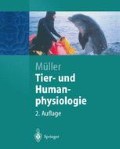Zusammenfassung
Große Worte über die Bedeutung chemischer Sinne für unser Leben zu verlieren, können wir uns ersparen. Es darf aber darauf hingewiesen werden, dass für viele Tiere, insbesondere für nachtaktive Säugetiere und soziale Insekten, chemische Sinne nicht nur zum Suchen und zur Prüfung der Nahrung und nicht nur zur Orientierung in einer duftenden Umwelt dienen, sondern auch im Dienste eines ausgeklügelten chemischen Kommunikationssystems stehen. Auch wenn wir Menschen tausend verschiedene Düfte wahrnehmen können, in der Empfindlichkeit, Diversität und Präzision bei der Identifizierung einzelner Substanzen und der Ortung ihrer Quelle sind uns zahlreiche Tiere, viele Insekten eingeschlossen, überlegen. Trotzdem ist auch heute noch bei nicht wenigen flüchtigen Molekülen die Nase des Chemikers oder professionellen Duftprüfers das leistungsfähigste Analysengerät.
Access this chapter
Tax calculation will be finalised at checkout
Purchases are for personal use only
Preview
Unable to display preview. Download preview PDF.
Literatur
Boppre M (1995) Pharmakophagie: Drogen, Sex und Schmetterlinge. Biol in unserer Zeit, 25(1): 8–17
Collin SP, Marshall NJ (2003) Sensory processing in aquatic environments. Springer Berlin Heidelberg New York Tokyo
Döcke F (1994) Veterinärmedizinische Endokrinologie, Kap 24: Pheromone. Fischer, Stuttgart, S 691–712
Dulac C, Axel R (1995) A novel family of genes encoding putative pheromone receptors in mammals. Cell 83: 195–206
Freeman WJ (1994) Physiologie und Simulation der Geruchswahrnehmung. In: Singer W (Hrsg) Gehirn und Bewußt-sein. Spektrum, Weinheim, S 22–31
Jackson JF, Linskens HF (2002) Analysis of taste and aroma. Springer, Berlin Heidelberg New York Tokyo
Harborne JB (1995) Ökologische Biochemie. Spektrum, Heidelberg Berlin
Hasler AD, Scholz AT (1983) Imprinting and homing in salmon. Springer, Berlin Heidelberg New York Tokyo
Kleerekoper H (1982) The role of olfaction in the orientation of fishes. In: Hara TJ (ed) Chemoreception in fishes. Elsevier, Amsterdam, pp 201–225
Krieger J, Breer H(1994) Der Geruchsinn: Die Grundlagen der Duftwahrnehmung. Biol in unserer Zeit 24 (2): 70–76
Meredith M (2001) Human vomeronasal organ function: a critical review of best and worst cases. Chem Sens 26:433–445
Mombaerts P (2001) The human repertoire of odorant genes and pseudogenes. Annu Rev Genomics Hum Genet 2: 493–510
Ohloff G (1994) Scent and fragrances. The fascination of odors and their chemical perspectives. Springer, Berlin Heidelberg New York Tokyo
Schild C (1996) Olfaction and taste. In: Greger G, Windhorst U (eds) Comprehensive human physiology. Springer, Berlin Heidelberg New York Tokyo, pp 847–860
Smith DV, Margolskee RF (2001) Das Geheimnis des Geschmacksinns. Spektrum Juli 2001: 38–46
Takami S (2002) Recent progress in the neurobiology of the vomeronasal organ. Microcop Research Technique 58: 228–250
Yamaguchi K et al. (1981) Distinctive urinary odors governed by the major histocompatibility locus of the mouse. Proc Natl Acad Sci USA 78: 5817–5820
Author information
Authors and Affiliations
Rights and permissions
Copyright information
© 2004 Springer-Verlag Berlin Heidelberg
About this chapter
Cite this chapter
Müller, W. (2004). Chemische Sinne. In: Tier- und Humanphysiologie. Springer-Lehrbuch. Springer, Berlin, Heidelberg. https://doi.org/10.1007/978-3-662-10555-9_20
Download citation
DOI: https://doi.org/10.1007/978-3-662-10555-9_20
Publisher Name: Springer, Berlin, Heidelberg
Print ISBN: 978-3-662-10556-6
Online ISBN: 978-3-662-10555-9
eBook Packages: Springer Book Archive

